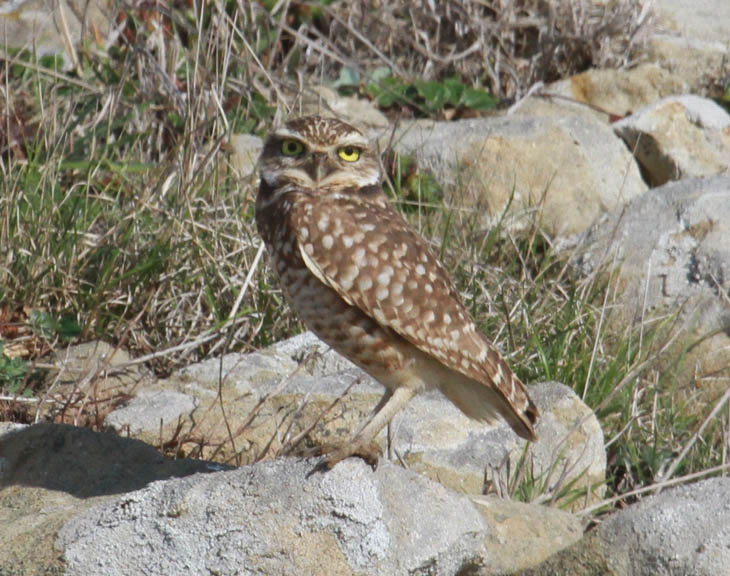Burrowing Owl

Burrowing Owl {Athene cunicularia} Photo by Jamie Hall
This owl was observed for the third time on December 14, 2017 by Jamie Hall, Charon Vilnai, and Song Hunter on their monthly Beach Watch survey at Fort Ross State Historic Park.
Information from The Cornell Lab of Ornithology
Owls are unmistakable birds, and that goes double for a long-legged owl that hunts on the ground during the day. Burrowing Owls are small, sandy colored owls with bright-yellow eyes. They live underground in burrows they’ve dug themselves or taken over from a prairie dog, ground squirrel, or tortoise. They live in grasslands, deserts, and other open habitats, where they hunt mainly insects and rodents. Their numbers have declined sharply with human alteration of their habitat and the decline of prairie dogs and ground squirrels.
Cool Facts
- Unlike most owls in which the female is larger than the male, the sexes of the Burrowing Owl are the same size.
- Burrowing Owls often stow extra food to ensure an adequate supply during incubation and brooding. When food is plentiful, the birds' underground larders can reach prodigious sizes. One cache observed in Saskatchewan in 1997 contained more than 200 rodents.
- In the absence of suitable homes created by ground squirrels, prairie dogs, desert tortoises, or other burrowing animals, Burrowing Owls have been known to nest in piles of PVC pipe and other lairs unintentionally provided by humans. Conservationists make use of the owls' adaptability by supplying artificial burrows made of buckets, pipes, tubing, and other human-made materials.
- Burrowing Owls have a higher tolerance for carbon dioxide than other birds—an adaptation found in other burrowing animals, which spend long periods underground, where the gas can accumulate to higher levels than found above ground.
- Efforts to protect Burrowing Owl populations can turn into complex ecological juggling acts. On a naval base near San Diego, California, land managers had to balance the needs of declining Burrowing Owls with a colony of endangered Least Terns, whose chicks the owls sometimes preyed upon.
- Before laying eggs, Burrowing Owls carpet the entrances to their homes with animal dung, which attracts dung beetles and other insects that the owls then catch and eat. They may also collect bottle caps, metal foil, cigarette butts, paper scraps, and other bits of trash at the entrance, possibly signifying that the burrow is occupied.
- The oldest known Burrowing Owl was at least 9 years, 11 months old when it was sighted in California in 2014.
For more excellent information on burrowing owls and all other birds, check out The Cornell Lab of Ornithology